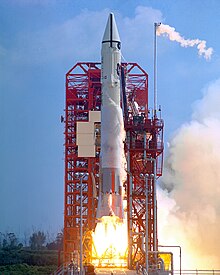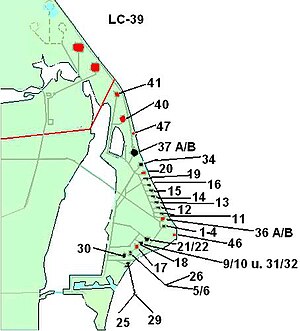Space Launch Complex 36
| CCAFS SLC-36 | |
|---|---|

|
|
| Atlas Centaur with Mariner 10 on pad 36B | |
| Coordinates | 28 ° 28 ′ 11 ″ N , 80 ° 32 ′ 22 ″ W |
| Type | Orbital Launch Site |
| operator | NASA / US Air Force / General Dynamics / Blue Origin |
| start of building | 1961 (36A) / 1963 (36B) |
| Launch pads | 2 (36A, 36B) |
| Missiles | Atlas , New Glenn |
| First start | May 9, 1962 |
| Last start | February 3, 2005 (NOSS 3) |
| Total starts | 145 |
| status | in work |
The Space Launch Complex 36 ( SLC-36 , previously Launch Complex 36 , LC-36) is one of Space Florida powered rocket launch site on the grounds of the Cape Canaveral Air Force Station on Merritt Iceland , Cape Canaveral in Florida , USA . It consisted of the two launch ramps 36A and 36B and is currently being completely rebuilt.
SLC-36 was responsible for the exploration of the solar system is of great importance: Surveyor - Mariner - and Pioneer - space probes launched from here.
history

Construction work on Launch Complex 36 began in February 1961. At that time, only Pad A was built. It took a few more years until Pad B was finally built in early 1963.
Until the end of 1989 the ramps were under the control of NASA. During this time, major research missions started from the complex: After a few tests with Surveyor models, Surveyor 1 was launched on May 30, 1966 , followed by the other probes in this series. Between February 1969 and November 1973, Mariner Missions 6 to 10 were launched. Next they launched a series of Intelsat satellites and Pioneer 10 , 11 and the two Pioneer Venus probes.
After that, NASA handed the ramps over to the US Air Force and General Dynamics , which they used for military and commercial projects. The first commercial rocket was launched on December 7, 1991, the first military satellite on February 11, 1992.
The launches of SLC-36 were suspended in October 2005 and on June 16, 2007 both launch pads were blown up with 55 kg of dynamite.
In August 2008, Space Florida, a federal agency promoting the aerospace industry in Florida, announced that it had signed a contract with the USAF to remodel and commercialize SLC-36.
In September 2015, the US space company Blue Origin rented the facility. It demolished the old Atlas launch equipment and is currently building a new launch device for New Glenn rockets. The first start of the New Glenn is planned for 2020. Blue Origin plans both unmanned and manned missions.
The complex
SLC-36 consisted of two very similar launch ramps: There was a mobile service tower (MST) and a smaller auxiliary tower (Umbilical Tower (UT)), which supplied the Atlas missile until shortly before launch and was not movable . The towers were 56.38 m and 63.7 m high, respectively.
Like many service towers, the MST had a crane with which the upper stage and payload could be assembled. However, the first stage was connected with ropes that were not attached to the crane and set up together with the trailer of the truck .
Even after the turn of the millennium, the control bunker indicated that the towers were built a few decades ago: it is brownish with a rounded roof and is very close to the ramps.
Start list
Assembling an Atlas on SLC-36
Web links
- Cape Canaveral LC36A and LC36B in the Encyclopedia Astronautica (English)
- LC-36 in the CCAFS tour (English)
Individual evidence
- ↑ Cape Canaveral Spaceport Master Plan. (pdf) Spaceport Florida, January 2017, accessed on March 18, 2019 .
- ↑ Complex 36 mobile service towers brought down , spaceflightnow.com (English)
- ↑ Former Atlas launch towers knocked down at Complex 36 , spaceflightnow.com (English)
- ↑ US Air Force to license Launch Complex 36 to Space Florida , press release from Space Florida (English)
- ↑ Chris Bergen: Blue Origin take over LC-36 at the Cape - prepare for orbital launches. In: nasaspaceflight.com. September 15, 2015, accessed March 23, 2018 .
- ↑ Chris Gebhard: Blue Origin remains on course for 2020 debut of New Glenn heavy lift rocket. In: nasaspaceflight.com. November 10, 2017, accessed March 23, 2018 .





